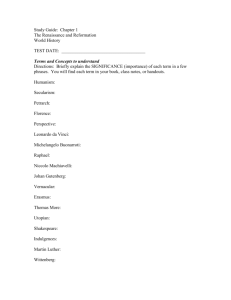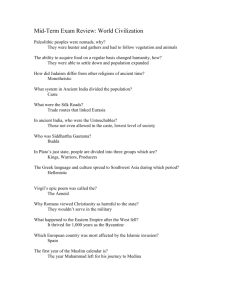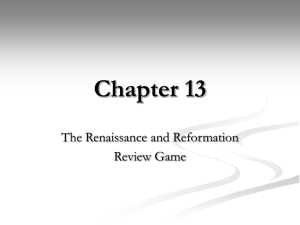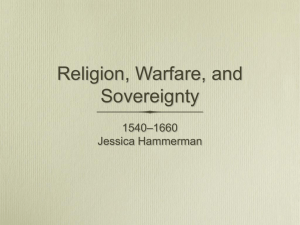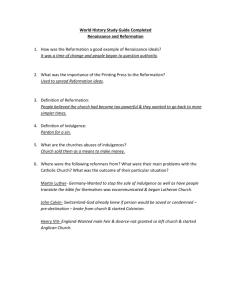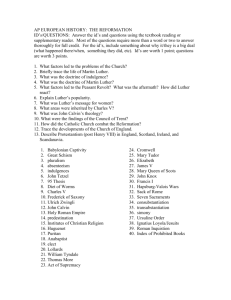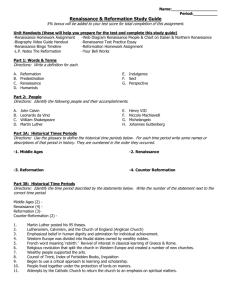unit 1 test review - Montgomery County Schools
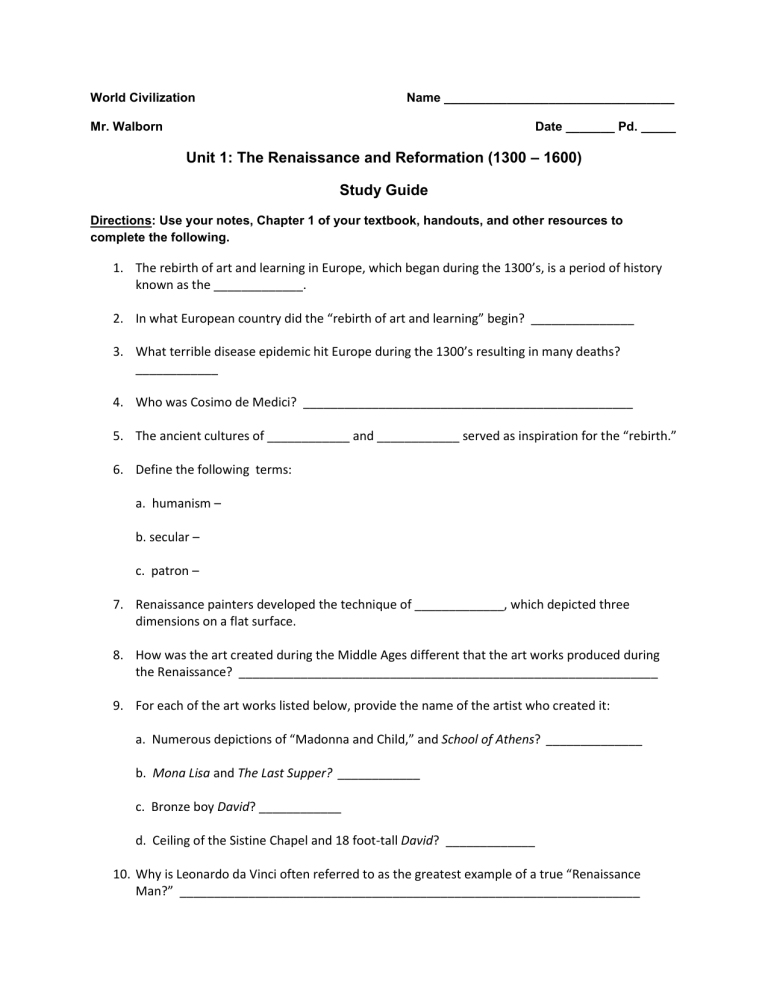
World Civilization Name _________________________________
Mr. Walborn Date _______ Pd. _____
Unit 1: The Renaissance and Reformation (1300
– 1600)
Study Guide
Directions: Use your notes, Chapter 1 of your textbook, handouts, and other resources to complete the following.
1.
The rebirth of art and learning in Europe, which began during the 1300’s, is a period of history known as the _____________.
2.
In what European country did the “rebirth of art and learning” begin? _______________
3.
What terrible disease epidemic hit Europe during the 1300’s resulting in many deaths?
____________
4.
Who was Cosimo de Medici? ________________________________________________
5.
The ancient cultures of ____________ and ____________ served as inspiration for the “rebirth.”
6.
Define the following terms: a. humanism – b. secular – c. patron –
7.
Renaissance painters developed the technique of _____________, which depicted three dimensions on a flat surface.
8.
How was the art created during the Middle Ages different that the art works produced during the Renaissance? _____________________________________________________________
9.
For each of the art works listed below, provide the name of the artist who created it: a. Numerous depictions of “Madonna and Child,” and School of Athens? ______________ b. Mona Lisa and The Last Supper? ____________ c. Bronze boy David? ____________ d. Ceiling of the Sistine Chapel and 18 foot-tall David? _____________
10.
Why is Leonardo da Vinci often referred to as the greatest example of a true “Renaissance
Man?” ___________________________________________________________________
11.
This writer and poet _____________, known for his 14-line poems called ______________, is sometimes considered the father of Renaissance humanism.
12.
Niccolo Machiavelli’s book ____________ was written as a guidebook for political rulers and was concerned not by what was morally correct, rather with what was politically effective.
13.
How did the ideals of the Renaissance spread to Northern Europe during the late 1400s?
______________________________________________________________________________
14.
Jan van Eyck and Pieter Bruegel were painters from the wealthy region of _______________, the artistic center of the Northern Renaissance, located in present day France and Holland.
15.
The Christian Humanists of the Northern Renaissance were critical of the _________________ and wanted to reform society by promoting opportunities for citizens to get an education.
16.
Thomas More wrote a book in 1516 entitled ______________, which means “no place,” about a fictional, ideal land where greed, corruption, and war did not exist.
17.
The Queen of England and Henry VIII’s youngest daughter who brought the Renaissance to
England during her rule from 1558 to 1603 was ____________.
18.
The most famous writer of the Elizabethan Age was English playwright _____________. Give three examples of his famous plays. _______________________________________________
19.
What famous invention was Johann Gutenberg credited with? _____________
20.
Martin Luther led a religious movement in Europe which marked the beginning of a historical period known as the _____________.
21.
In 1517, Luther posted his ____________ , a list of formal criticisms of the Catholic church, on the church door at Wittenberg.
22.
What Church practice used by Johann Tetzel and others did Luther find especially upsetting?
_____________________________________________________________________________
23.
Briefly identify the following with regard to their impact on Martin Luther: a. Pope Leo X – d. Lutherans - b. Edict of Worms – c. Emperor Charles V - e. Prince Frederick the Wise f. Peace of Augsburg -
24.
Why did Henry VIII want his marriage to Catherine of Aragon annulled by the Pope?
_____________________________________________________________________________
25.
What church did Henry VIII establish in England? _____________________________________
26.
Followers of John Calvin’s teachings are known as ________________.
27.
Explain the following as they relate to John Calvin’s religious views: a. predestination - b. theocracy –
28.
Followers of Calvinism in Scotland were led by ______________ and they were called
______________.
29.
People like Luther and Calvin who either challenged the Catholic Church or “protested” its teachings are often referred to as__________ _______.
30.
Protestants who lived in France during the 1300’s were known as _________________.
31.
The movement to reform the Catholic Church was called the _______________ Reformation or the Catholic Reformation.
32.
What was the purpose of the Inquisition regarding the protection of the Catholic faith?
______________________________________________________________________________
33.
__________________ Sources are written by the author.
34.
STRUCTURED RESPONSE: Martin Luther did not want the church in control of people, he did however, recognize that a King while being an evil was a lesser evil than the church and better to rule. Explain why?

